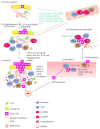Tumor-Associated Macrophages and Neutrophils in Tumor Microenvironment
- PMID: 26966341
- PMCID: PMC4757693
- DOI: 10.1155/2016/6058147
Tumor-Associated Macrophages and Neutrophils in Tumor Microenvironment
Abstract
Distinct tumor microenvironment forms in each progression step of cancer and has diverse capacities to induce both adverse and beneficial consequences for tumorigenesis. It is now known that immune cells can be activated to favor tumor growth and progression, most probably influenced by the tumor microenvironment. Tumor-associated macrophages and tumor-associated neutrophils can exert protumoral functions, enhancing tumor cell invasion and metastasis, angiogenesis, and extracellular matrix remodeling, while inhibiting the antitumoral immune surveillance. Considering that neutrophils in inflammatory environments recruit macrophages and that recruited macrophages affect neutrophil functions, there may be various degrees of interaction between tumor-associated macrophages and tumor-associated neutrophils. Platelets also play an important role in the recruitment and regulation of monocytic and granulocytic cells in the tumor tissues, suggesting that platelet function may be essential for generation of tumor-associated macrophages and tumor-associated neutrophils. In this review, we will explore the biology of tumor-associated macrophages and tumor-associated neutrophils and their possible interactions in the tumor microenvironment. Special attention will be given to the recruitment and activation of these tumor-associated cells and to the roles they play in maintenance of the tumor microenvironment and progression of tumors.
Figures



References
-
- Rezaei N. Cancer Immunology: A Translational Medicine Context. Berlin, Germany: Springer; 2015. - DOI
-
- Van Overmeire E., Laoui D., Keirsse J., Van Ginderachter J. A., Sarukhan A. Mechanisms driving macrophage diversity and specialization in distinct tumor microenvironments and parallelisms with other tissues. Frontiers in Immunology. 2014;5, article 127 doi: 10.3389/fimmu.2014.00127. - DOI - PMC - PubMed
Publication types
MeSH terms
LinkOut - more resources
Full Text Sources
Other Literature Sources

